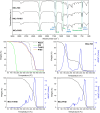Microcapsules of Poly(butylene adipate- co-terephthalate) (PBAT) Loaded with Aliphatic Isocyanates for Adhesive Applications
- PMID: 38807950
- PMCID: PMC11129179
- DOI: 10.1021/acsapm.4c00033
Microcapsules of Poly(butylene adipate- co-terephthalate) (PBAT) Loaded with Aliphatic Isocyanates for Adhesive Applications
Abstract
This work introduces the encapsulation of hexamethylene diisocyanate derivatives (HDI, TriHDI, and PHDI) with the biodegradable polymer poly(butylene adipate-co-terephthalate) (PBAT) through a solvent evaporation method. These microcapsules (MCs) were then employed in adhesive formulations for footwear. Moreover, MCs containing PHDI were produced in a closed vessel, demonstrating the potential for recovering and reusing organic solvents for the first time. The MCs were achieved with an isocyanate payload reaching up to 68 wt %, displaying a spherical shape, a core-shell structure, and thin walls without holes or cracks. The application of MCs as cross-linking agents for adhesives was evaluated following industry standards. The adhesives' strength surpassed the minimum requirement by a significant margin. Creep tests demonstrated that the formulation with MCs exhibits superior thermostability. Furthermore, the formulation with MCs-PHDI presented the best results reported to date for this type of system, as no displacement was observed in the bonded substrates. Environmental assessment indicates that adhesives with MCs have higher global warming potential (+16.2%) and energy consumption (+10.8%) than the standard commercial adhesives, but under alternative realistic scenarios, the differences can be insignificant. Therefore, adhesive formulations incorporating MCs promise to be on par with traditional adhesive systems regarding environmental impacts while providing benefits such as improved and safe handling of isocyanates and excellent bonding effectiveness.
© 2024 The Authors. Published by American Chemical Society.
Conflict of interest statement
The authors declare no competing financial interest.
Figures







References
-
- Eram S.; Fahmina Z.. Polyurethane: An Introduction. In Polyurethane; Fahmina Z.; Eram S., Eds.; IntechOpen: Rijeka, 2012; pp 1–14.
-
- Michael S.Structure–Property Relations in Polyurethanes. In Szycher’s Handbook of Polyurethanes; CRC Press, 2012; pp 87–135.
-
- Poljanšek I.; Fabjan E.; Moderc D.; Kukanja D. The effect of free isocyanate content on properties of one component urethane adhesive. Int. J. Adhes. Adhes. 2014, 51, 87–94. 10.1016/j.ijadhadh.2014.02.012. - DOI
LinkOut - more resources
Full Text Sources

